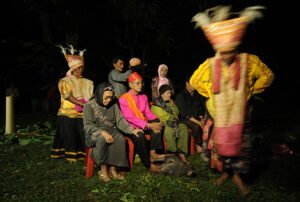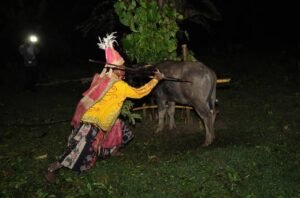IDNtribune.com, Palu – Central Sulawesi is the largest province on the island of Sulawesi, Indonesia. Its indigenous population consists of 15 ethnic groups, the largest of which is the Kaili tribe, whose members inhabit much of the province, including the regions of Donggala, Sigi, Palu, Parigi Moutong, Tojo Una-Una, Poso, Tomini Bay, and the coastal areas of Poso.
Remarkably, the Kaili are an ethnic group with their own linguistic branches—more than 30 in total—such as Kaili Rai, Kaili Ledo, Kaili Ija, Kaili Moma, Kaili Da’a, Kaili Unde, Kaili Inde, Kaili Tara, Kaili Bare’e, Kaili Doi, and Kaili Torai. Each branch uses its own dialect in daily life, yet all are unified by a common language, Ledo, which serves as a lingua franca among the Kaili people.
Like many other ethnic groups across the Indonesian archipelago, the Kaili tribe has preserved its traditional culture and rituals. One of the most well-known of these is the Balia Dance, an ancient healing ritual believed to cure illnesses caused by malevolent spirits or supernatural forces. Locals often refer to this ritual as a form of spiritual medicine or “health warrior.”

Historically, the Balia Dance was primarily performed for noble families. It was not conducted arbitrarily; instead, it was reserved for cases in which conventional medical treatment failed to bring recovery. The Kaili people believed that the dance could restore health by driving away evil spirits responsible for sickness.
Unlike other traditional dances, Balia includes a dramatic and extreme act—walking barefoot on burning embers. The word Balia itself means to challenge, symbolizing the confrontation between the healer and the evil spirits. In ancient belief, stepping on fire represents the destruction of anger, impurity, and negative energy.
The ritual can be conducted individually or in groups, and its duration depends on the severity of the illness—the more serious the disease, the longer the ceremony. The Balia ritual is divided into three main levels: Balia Bone, Balia Jinja, and Balia Tampilangi.
-
Balia Bone is the most basic level, typically performed for minor ailments. A sando (traditional healer) leads the ritual, which usually takes place over a short duration.
-
Balia Jinja involves a larger group of participants, including the sando, the bale (assistants), the patient, and onlookers. The participants move in a circular motion while chanting the sacred dondulu. During the performance, some participants may enter a trance state.
-
Balia Tampilangi is the most sacred and elaborate level, often reserved for nobility. This version combines all movements from the previous two levels and can last for three to four days, requiring specific ceremonial conditions to be fulfilled.
The full Balia ceremony consists of ten stages, including pompoura or tala bala’a, enje da’a, tampilangi ulujadi, pompoura vunja, manuru viata, jinja, balia topoledo, vunja ntana, tampilangi, and nora binangga.
During the preparations, offerings such as incense, fruit, symbolic coffins, and sacrificial animals—ranging from chickens to goats or buffaloes, depending on the host’s social status—are arranged. The animal sacrifices symbolize a sincere plea for recovery. The ceremony is accompanied by the melodic sounds of the lalove (flute) and gimba (drum), which guide the rhythm of the ritual.

When the preparations are complete, a male shaman begins reciting chants and mantras to summon ancestral spirits. Different offerings are placed near the incense for each stage. The patient remains close to the dancers until the ritual reaches its conclusion.
For the Kaili people, Balia is more than a performance—it is a deeply spiritual act of healing and cultural identity. While many still believe in its power to cure diseases, others, influenced by modern lifestyles, prefer medical treatment through doctors and healthcare professionals.
Nevertheless, the Balia Dance remains a living testament to the Kaili tribe’s enduring respect for their ancestral traditions and the harmony between the physical and spiritual realms.


















